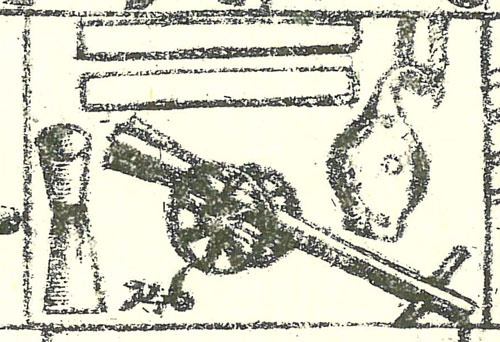
CXLVI. He beareth in this quarter several sorts of Engines used by Carpenters. The first are two Levers in the chief; these are square or round Poles, some call them Wayes, by which the Rowler of the Crab Engine is turned about, to draw up heavy Timber to a considerable height: They are termed also Pudlaies or Hand-spikes.
The Ten Foot Rod or Rule, is an Instrument of Wood like one of these, being no other than the Rib of a slit Deal plained streight, by which Ground Plots are measured, for the laying of Foundations of Houses; it is divided into ten parts, each containing a Foot.
The second Tool, which is set on the dexter side is termed a Ripping Chissel; it is a Socket Chissel, about an inch broad with a blunt Edge, not having a Basil, as almost all other Chissels have, and therefore would more properly be termed a Wedge than a Chissel; but most commonly Carpenters use an old cast off Chissel for a Ripping Chissel. Its Office is not to cut Wood, but to rip or tear 2 pieces of Wood fastned together from one another, by entring the blunt edge of it between the two pieces, and so forcing them asunder, by Blows with the Mallet.
The third, which is in the Fess point, and standeth Bendways, is termed a Drug; it is an Engine set upon two Wheels, made somewhat like a low narrow Cart Bottom. It is used for the Carriage of Timber, and then it is drawn by the handle by two or more Men, according as the weight of the Timber may require. Gules, the like to this in Bend Or, between two Pheons Argent, is born by Don Lazallo a Spanish Family.
The fourth in the Sinister chief, is a Pulley hung by the Hook in the Noose of a Rope out of the chief. This being single is termed only a Pully, but if it have more than one turn or little Wheel in it, for the Rope to run in, it is termed by most a Snatch Block, or double Snatch Block; but of the several parts and terms belonging to these Drawing Blocks, see chap. 15. numb. 45.
— From Randle Holme’s “The Academy of Armory, or, A Storehouse of Armory and Blazon” Book III, Chapter VIII, Plate 2. Why am I reading this?